#Global Product Platform
Text
So... quick update on the Eurovision situation
The EBU decided that Israel can compete despite their country being under an active Genocide investigation by the ICJ. Their delegation have gone on to antagonise other contestants by filming them for their social media without permission and refusing to remove it when asked, harass journalists who have questioned if their inclusion is appropriate, and their commentators have made horrendous comments about the Irish contestant... all without sanction.
Meanwhile the Dutch contestant got into an undisclosed 'incident' with a female member of the production crew and they've referred it to the police and flat out disqualified him from the contest with less than 12 hours notice...
Which seems like a tremendous act of double standards at an event that is already marred by serious controversy. Obviously the second is not acceptable, but very difficult to understand how the first somehow... is?
#eurovision#eurovision 2024#I have had very mixed feelings with regard to the boycott for a very long time#And whilst I understand the sentiment#I'm still not sure it's the right course of action in terms of how the competition works and who profits from it#And I'm not saying his disqualification is unwarranted (it's impossible to gauge without the full incident details)#More that the other disqualification that they refuse to make is MORE warranted#I feel most sorry for the contestants amongst all of this#Most of whom are there because the global platform is absolutely unmatched in them being able to share their own personal story#And a lot of them come from a variety of queer and minority groups who do not get the chance at a global stage like this... ever#The issue is the EBU and their cowardice to handle this situation effectively#And that's because they've allowed their hands to be tied by their sponsor#It feels tragically obvious what's going to happen tonight#And it's not going to achieve the message I think a lot of people are idealistically thinking it will#It's going to serve as a signal of approval for them to use as ammunition for further attacks and be counter productive imho
77 notes
·
View notes
Text
How Buy4Me Simplifies International Shopping: A Traveler’s Perspective

In a world where globalization connects us more than ever, the desire to shop internationally has grown exponentially. However, cross-border shopping often comes with several challenges, including shipping costs, customs duties, and product availability. Buy4Me.io, a leading traveler assistance platform, has revolutionized the international shopping experience by making it seamless, convenient, and stress-free. In this blog, we’ll dive into how Buy4Me simplifies international shopping, offering a traveler’s perspective on how the platform transforms global purchases.
1. Eliminate Shipping Hassles
One of the biggest obstacles when shopping internationally is dealing with complex shipping logistics. High shipping fees, unreliable delivery services, and customs complications can turn what should be a fun shopping experience into a headache. Buy4Me.io steps in by offering international shopping made simple with traveler assistance. The platform partners with experienced travelers who are already headed to your desired country. These travelers purchase the items on your behalf and bring them back, avoiding many shipping-related headaches.
By using Buy4Me, you don’t have to worry about tracking packages or whether your items will arrive safely. Cross-border item delivery through traveler networks ensures your items are in trusted hands, providing a smoother, more personal delivery experience.
2. Access to Exclusive International Products
Many international products are either unavailable in your country or carry a hefty price tag due to import fees. Whether it’s a unique fashion item from Italy, the latest tech gadget from Japan, or exclusive skincare products from South Korea, Buy4Me.io allows you to find unique items abroad with Buy4Me.io travelers. This access to rare and exclusive products is one of the key advantages of using the platform.
From a traveler’s perspective, it’s a win-win scenario. The traveler gets to make extra money while on their journey, and the buyer gains access to products that would otherwise be hard to obtain. Buy4Me.io simplifies access to these exclusive items, ensuring that you never miss out on global trends and rare finds.
3. Save Money on Customs and Shipping Fees
International purchases often come with added costs like customs duties and high shipping fees, which can make buying items from abroad expensive. Buy4Me.io offers a cost-effective solution by connecting buyers with travelers who can bring back your items without these extra costs. Through cross-border item delivery through traveler networks, the platform allows you to negotiate delivery fees with travelers, which are often significantly lower than traditional shipping services.
Moreover, since travelers are physically bringing back your items, you can avoid hefty customs fees. Travelers assist with customs clearance, ensuring that you receive your product without the worry of additional charges.
4. Secure and Reliable Transactions
Security is a top concern when shopping online, especially with international transactions. Buy4Me.io has established a system that guarantees secure payments and ensures that both the traveler and buyer are protected. The platform uses trusted payment gateways, providing peace of mind that your money and products are safe throughout the process.
Additionally, you can track your transaction and communicate with the traveler to ensure everything runs smoothly. Buy4Me takes every step necessary to ensure that international shopping is made simple with traveler assistance, and that the process is not only convenient but also secure.
5. Hassle-Free Returns and Exchanges
One of the most difficult parts of international shopping is returning or exchanging items if they don’t meet expectations. Buy4Me.io helps solve this by offering assistance with returns and exchanges, facilitated by the traveler who brought your product. This streamlined process saves you time, money, and effort.
Conclusion
Shopping internationally no longer needs to be a daunting experience. Buy4Me.io simplifies the process by eliminating shipping hassles, providing access to exclusive products, saving money on customs, and offering secure, reliable transactions. Through cross-border item delivery through traveler networks, the platform ensures a seamless experience. Whether you’re looking to purchase rare items from overseas or want to save on international shipping fees, Buy4Me.io makes international shopping simple with traveler assistance—delivering a truly effortless global shopping experience.
#International shopping made simple with traveler assistance#Cross-border item delivery through traveler networks#Buy products abroad with Buy4Me#Find unique items abroad with Buy4Me.io travelers#Affordable international shopping platform#Global shopping through travelers#How to avoid customs fees when shopping internationally#Secure international purchases with Buy4Me#Buy foreign products with traveler assistance#Hassle-free cross-border shopping with Buy4Me.io
0 notes
Text

Health Nutrition
A comprehensive health and nutrition platform for achieving wellness goals. Offers nutritional products, exercises, community support, and health coaches. Global expansion strategy with brand awareness focus.
"Please click on this link to get the product or to get an idea about it."https://healthnutrition.com/?_ef_transaction_id=&oid=7&affid=37573
#Health#nutrition#wellness#platform#products#exercises#community#support#coaches#global expansion#brand awarenes
1 note
·
View note
Note
are there any critiques of AI art or maybe AI in general that you would agree with?
AI art makes it a lot easier to make bad art on a mass production scale which absolutely floods art platforms (sucks). LLMs make it a lot easier to make content slop on a mass production scale which absolutely floods search results (sucks and with much worse consequences). both will be integrated into production pipelines in ways that put people out of jobs or justify lower pay for existing jobs. most AI-produced stuff is bad. the loudest and most emphatic boosters of this shit are soulless venture capital guys with an obvious and profound disdain for the concept of art or creative expression. the current wave of hype around it means that machine learning is being incorporated into workflows and places where it provides no benefit and in fact makes services and production meaningfully worse. it is genuinely terrifying to see people looking to chatGPT for personal and professional advice. the process of training AIs and labelling datasets involves profound exploitation of workers in the global south. the ability of AI tech to automate biases while erasing accountability is chilling. seems unwise to put a lot of our technological basket in a completely opaque black box basket (mixing my metaphors ab it with that one). bing ai wont let me generate 'tesla CEO meat mistake' because it hates fun
3K notes
·
View notes
Text
#Customer Communication and Engagement Platform#global digital payment system#Utility Bill Payment#Utilities Customer Experience#TilliCX software#Advance communication and payment products
0 notes
Text
The Best News of Last Week
🌍🌡️ - Climate Prophecy: The Forecast Is 100% Chance of 'Cool'
1. No cases of cancer caused by HPV in Norwegian 25-year olds, the first cohort to be mass vaccinated for HPV
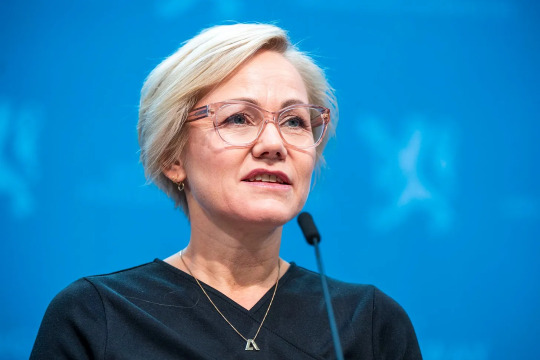
Last year there were zero cases of cervical cancer in the population that was vaccinated in 2009 against the HPV virus, which can cause the cancer in women. The HPV virus is extremely common, basically everyone comes into contact with one version or another of the virus in their lifetime.
The vaccine was given to girls only out of an abundance of caution, they were the most likely to contract cancer from the viruses, and because there was limited supply.
2. ‘Every square inch is covered in life’: the ageing oil rigs that became marine oases

Built decades ago, California’s offshore oil platforms are home to a huge diversity of marine life. According to a 2014 study, the rigs were some of the most “productive” ocean habitats in the world, a term that refers to biomass – or number of fish and other creatures and how much space they take up – per unit area.
3. Vaccinations may have prevented almost 20 million COVID-19 deaths worldwide

Vaccinations estimated to have averted 19.8 million COVID-19 deaths worldwide in their first year, according to the latest Imperial modelling study.
In the first year of the vaccination programme, 19.8 million out of a potential 31.4 million COVID-19 deaths were prevented worldwide according to estimates based on excess deaths from 185 countries and territories.
4. Global climate policy forecast predicts ‘well below 2°C’ Paris Agreement climate goals will be met

They report only a 10% probability we exceed 2°C by 2050. Temperatures are expected to peak between 1.7°C and 1.8°C, which is consistent with the “well below 2°C” objective of the Paris Agreement in Art. 2.1c.
5. Young driver fatality rates have fallen sharply in the US, helped by education, technology

Crash and fatality rates among drivers under 21 have fallen dramatically in the U.S. during the past 20 years.
Using data from 2002-2021, the report says that fatal crashes involving a young driver fell by 38%, while deaths of young drivers dropped even more, by about 45%.
6. A Virginia woman was feeling sad. Her doctor prescribed her a cat.
7. Remote workers report saving $5,000 to $10,000 a year

What value would American workers place on the privilege to work from home?
In a 2022 survey by FlexJobs, 45% of remote workers reported saving at least $5,000 a year. One in 5 reported saving $10,000 a year. The savings average out to about $6,000 a year. The poll reached 4,000 workers in July and August of last year.
Three years into the remote-work revolution, research increasingly suggests that telework is a commodity, a job descriptor worth thousands of dollars in potential savings and improved quality of life.
---
That's it for this week :)
This newsletter will always be free. If you liked this post you can support me with a small kofi donation here:
Buy me a coffee ❤️
Also don’t forget to reblog this post with your friends.
1K notes
·
View notes
Text
"In a bid to slow deforestation in the Amazon, Brazil announced Tuesday [September 5, 2023,] that it will provide financial support to municipalities that have reduced deforestation rates the most.
During the country´s Amazon Day, President Luiz Inácio Lula da Silva also signed the creation of two Indigenous territories that total 207,000 hectares (511,000 acres) — over two times the size of New York City — and of a network of conservation areas next to the Yanonami Indigenous Territory to act as a buffer against invaders, mostly illegal gold miners.
“The Amazon is in a hurry to survive the devastation caused by those few people who refuse to see the future, who in a few years cut down, burned, and polluted what nature took millennia to create,” Lula said during a ceremony in Brasilia. “The Amazon is in a hurry to continue doing what it has always done, to be essential for life on Earth.”
The new program will invest up to $120 million in technical assistance. The money will be allocated based on the municipality´s performance in reducing deforestation and fires, as measured by official satellite monitoring. A list of municipalities eligible for the funds will be published annually.
The resources must be invested in land titling, monitoring and control of deforestation and fires, and sustainable production.
The money will come from the Amazon Fund, which has received more than $1.2 billion, mostly from Norway, to help pay for sustainable development of the region. In February, the United States committed to a $50 million donation to the initiative. Two months later, President Joe Biden announced he would ask Congress for an additional $500 million, to be disbursed over five years.
The most critical municipalities are located along the arc of deforestation, a vast region along the southern part of the Amazon. This region is a stronghold of former far-right President Jair Bolsonaro, who favored agribusiness over forest preservation and lost the reelection last year.
“We believe that it’s not enough to just put up a sign saying ‘it’s forbidden to do this or that. We need to be persuasive.” Lula said, in a reference to his relationship with Amazon mayors and state governors.
Lula has promised zero net deforestation by 2030, although his term ends two years earlier. In the first seven months of his third term, there was a 42% drop in deforestation.
[Note: For context, Lula's third term as president started January 1, 2023. It was not continuous with his first two terms, when he was president from 2003 to 2010. Lula's third term has been a historic and desperately needed reversal of the anti-environmental, etc. policies of Bolsonaro, whose term ended at the end of 2022.]
Brazil is the world’s fifth-largest emitter of greenhouse gases, with almost 3% of global emissions, according to Climate Watch, an online platform managed by World Resources Institute. Almost half of these emissions come from deforestation. Under the 2015 Paris Agreement, Brazil committed to reducing carbon emissions by 37% by 2025 and 43% by 2030."
-via AP, September 5, 2023
#brazil#deforestation#lula da silva#amazon#amazon rainforest#environmentalism#fossil fuels#environment#environmental justice#land back#illegal miners#yanonami#indigenous#first nations#greenhouse gasses#conservation#good news#hope
379 notes
·
View notes
Text
The Metaverse: A New Frontier in Digital Interaction

The concept of the metaverse has captivated the imagination of technologists, futurists, and businesses alike. Envisioned as a collective virtual shared space, the metaverse merges physical and digital realities, offering immersive experiences and unprecedented opportunities for interaction, commerce, and creativity. This article delves into the metaverse, its potential impact on various sectors, the technologies driving its development, and notable projects shaping this emerging landscape.
What is the Metaverse?
The metaverse is a digital universe that encompasses virtual and augmented reality, providing a persistent, shared, and interactive online environment. In the metaverse, users can create avatars, interact with others, attend virtual events, own virtual property, and engage in economic activities. Unlike traditional online experiences, the metaverse aims to replicate and enhance the real world, offering seamless integration of the physical and digital realms.
Key Components of the Metaverse
Virtual Worlds: Virtual worlds are digital environments where users can explore, interact, and create. Platforms like Decentraland, Sandbox, and VRChat offer expansive virtual spaces where users can build, socialize, and participate in various activities.
Augmented Reality (AR): AR overlays digital information onto the real world, enhancing user experiences through devices like smartphones and AR glasses. Examples include Pokémon GO and AR navigation apps that blend digital content with physical surroundings.
Virtual Reality (VR): VR provides immersive experiences through headsets that transport users to fully digital environments. Companies like Oculus, HTC Vive, and Sony PlayStation VR are leading the way in developing advanced VR hardware and software.
Blockchain Technology: Blockchain plays a crucial role in the metaverse by enabling decentralized ownership, digital scarcity, and secure transactions. NFTs (Non-Fungible Tokens) and cryptocurrencies are integral to the metaverse economy, allowing users to buy, sell, and trade virtual assets.
Digital Economy: The metaverse features a robust digital economy where users can earn, spend, and invest in virtual goods and services. Virtual real estate, digital art, and in-game items are examples of assets that hold real-world value within the metaverse.
Potential Impact of the Metaverse
Social Interaction: The metaverse offers new ways for people to connect and interact, transcending geographical boundaries. Virtual events, social spaces, and collaborative environments provide opportunities for meaningful engagement and community building.
Entertainment and Gaming: The entertainment and gaming industries are poised to benefit significantly from the metaverse. Immersive games, virtual concerts, and interactive storytelling experiences offer new dimensions of engagement and creativity.
Education and Training: The metaverse has the potential to revolutionize education and training by providing immersive, interactive learning environments. Virtual classrooms, simulations, and collaborative projects can enhance educational outcomes and accessibility.
Commerce and Retail: Virtual shopping experiences and digital marketplaces enable businesses to reach global audiences in innovative ways. Brands can create virtual storefronts, offer unique digital products, and engage customers through immersive experiences.
Work and Collaboration: The metaverse can transform the future of work by providing virtual offices, meeting spaces, and collaborative tools. Remote work and global collaboration become more seamless and engaging in a fully digital environment.
Technologies Driving the Metaverse
5G Connectivity: High-speed, low-latency 5G networks are essential for delivering seamless and responsive metaverse experiences. Enhanced connectivity enables real-time interactions and high-quality streaming of immersive content.
Advanced Graphics and Computing: Powerful graphics processing units (GPUs) and cloud computing resources are crucial for rendering detailed virtual environments and supporting large-scale metaverse platforms.
Artificial Intelligence (AI): AI enhances the metaverse by enabling realistic avatars, intelligent virtual assistants, and dynamic content generation. AI-driven algorithms can personalize experiences and optimize virtual interactions.
Wearable Technology: Wearable devices, such as VR headsets, AR glasses, and haptic feedback suits, provide users with immersive and interactive experiences. Advancements in wearable technology are critical for enhancing the metaverse experience.
Notable Metaverse Projects
Decentraland: Decentraland is a decentralized virtual world where users can buy, sell, and develop virtual real estate as NFTs. The platform offers a wide range of experiences, from gaming and socializing to virtual commerce and education.
Sandbox: Sandbox is a virtual world that allows users to create, own, and monetize their gaming experiences using blockchain technology. The platform's user-generated content and virtual real estate model have attracted a vibrant community of creators and players.
Facebook's Meta: Facebook's rebranding to Meta underscores its commitment to building the metaverse. Meta aims to create interconnected virtual spaces for social interaction, work, and entertainment, leveraging its existing social media infrastructure.
Roblox: Roblox is an online platform that enables users to create and play games developed by other users. With its extensive user-generated content and virtual economy, Roblox exemplifies the potential of the metaverse in gaming and social interaction.
Sexy Meme Coin (SEXXXY): Sexy Meme Coin integrates metaverse elements by offering a decentralized marketplace for buying, selling, and trading memes as NFTs. This unique approach combines humor, creativity, and digital ownership, adding a distinct flavor to the metaverse landscape. Learn more about Sexy Meme Coin at Sexy Meme Coin.
The Future of the Metaverse
The metaverse is still in its early stages, but its potential to reshape digital interaction is immense. As technology advances and more industries explore its possibilities, the metaverse is likely to become an integral part of our daily lives. Collaboration between technology providers, content creators, and businesses will drive the development of the metaverse, creating new opportunities for innovation and growth.
Conclusion
The metaverse represents a new frontier in digital interaction, offering immersive and interconnected experiences that bridge the physical and digital worlds. With its potential to transform social interaction, entertainment, education, commerce, and work, the metaverse is poised to revolutionize various aspects of our lives. Notable projects like Decentraland, Sandbox, Meta, Roblox, and Sexy Meme Coin are at the forefront of this transformation, showcasing the diverse possibilities within this emerging digital universe.
For those interested in the playful and innovative side of the metaverse, Sexy Meme Coin offers a unique and entertaining platform. Visit Sexy Meme Coin to explore this exciting project and join the community.
257 notes
·
View notes
Text
“There are only so many books on Ukraine we can review each month,” an editor from a major British newspaper tells me at one of the country’s largest literary festivals. He looks a bit uncomfortable, almost apologetic. He wants me to understand that if it were up to him, he’d review a book on Ukraine every day, but that’s just not how the industry works.
Since the start of Russia’s full-scale invasion, I’ve had a glimpse into how several industries work: Publishing, journalism, and the broader world of culture, including galleries and museums. Even before the big war, I knew more than I wanted to about how academia works (or rather doesn’t) when it comes to Ukraine. A common thread among all these fields is the limited attention they allocate to countries that do not occupy a place among the traditional big players of imperial politics.
Cultural imperialism lives on, even if its carriers often proclaim anti-colonial slogans. It thrives in gate-keeping, with editors and academics mistrusting voices that don’t sound like those higher up the ladder, while platforming those who have habitually been accepted as authoritative. “We’ve done Ukraine already” is a frequent response whenever you pitch an idea, text, or public event centering the country.
The editor who can’t keep publishing reviews of Ukraine-related books walks away, and I pick up a copy of one of the UK’s most prominent literary magazines to see their book recommendations. Out of a handful of reviews, three are on recent books about Russia. It seems like the space afforded to Russia remains unlimited. I close the publication to keep my blood pressure down.
Keeping my blood pressure down, however, is challenging. When my social media feeds aren’t advertising another production of Uncle Vanya, they’re urging me to splash out on opera tickets for Eugene Onegin. What happened to the dreaded “cancelling” of Russian culture? The Russia section in most bookshops I visit in the UK is growing daily with everything from yet another translation of Dostoevsky to accounts of opposition figures killed or imprisoned by the Kremlin.
The international media focus on the August 2024 release of Russian political prisoners was yet another example of how the more things change, the more they stay the same. While these released prisoners were provided with a global media platform to call for an end to “unfair” sanctions on “ordinary Russians,” there was no mention of the thousands of Ukrainian civilians who continue to languish in Russian jails.
The ongoing international emphasis on all things Russian goes hand in hand with a reluctance to transform growing interest in Ukraine into meaningful structural changes in how the country is perceived, reported on, and understood. Although there has been some improvement in knowledge about Ukraine since 2022, the move is essentially from having no understanding to having a superficial grasp.
Each time I read a piece on Ukraine by someone not well-versed in the country’s history and politics, my heart sinks. The chances are it will recycle historical cliches, repeat Kremlin propaganda about Russophone Ukrainians, or generalize about regional differences. And to add insult to injury, such articles also often misspell at least one family or place name, using outdated Russian transliterations. A quick Google search or a message to an actual Ukrainian could prevent these errors and save the author from looking foolish. Yet aiding this kind of colonial complacency seems to bother neither the authors nor the editors involved.
I often wonder what would happen if I wrote a piece on British or US politics and misspelt the names of historical figures, towns, and cities. How likely would I be to get it published? And yet the same standards do not apply when it comes to writing about countries that have not been granted priority status in our mental hierarchies of the world. We can misspell them all we like; no one will notice anyway. Apart from the people from those countries, of course. And when an exasperated Ukrainian writes to complain, I can almost see the editors rolling their eyes and thinking, “What does this perpetually frustrated nation want now? We’ve done Ukraine. Why are they never satisfied?”
It is not enough to simply “do Ukraine” by reviewing one book on the war, especially if it’s by a Western journalist rather than a Ukraine-based author. It’s not enough to host one exhibition, particularly if it is by an artist or photographer who only spent a few weeks in the country. Quickly putting together a panel on Russia’s war in response to a major development at the front and adding a sole Ukrainian voice at the last minute doesn’t cut it either. This box-ticking approach is unhelpful and insulting.
It is important to acknowledge that some Western media outlets have significantly enhanced their coverage of Ukraine over the past two and a half years. They have typically done so by dedicating time and resources to having in-house experts who have either reported from Ukraine for many years, or who are committed to deepening their knowledge enough to produce high-quality analysis. However, many of these outlets still seem compelled to provide platforms for individuals entirely unqualified to analyse the region. Surely this isn’t what balance means?
Since February 2022, more than 100 Ukrainian cultural figures have been killed in the war. According to the Ukrainian Ministry of Culture, by May 2024, over 2,000 cultural institutions had been damaged or destroyed. This includes 711 libraries, 116 museums and galleries, and 37 theatres, cinemas, and concert halls. In May 2024, Russia bombed Factor Druk, the country’s biggest printing house.
When I attended this year’s Kyiv Book Arsenal, Ukraine’s largest literary festival, each panel began with a minute of silence to honor the memory of colleagues killed in the war. All this is in addition to mounting military losses, many of whom are yesterday’s civilians, including journalists and creatives who have either volunteered or been drafted into the army. This is the current state of the Ukrainian creative industry.
To save time for Western editors, publishers, and curators, let me clarify what all of us perpetually frustrated Ukrainians want. We would appreciate it if they turned to actual Ukraine specialists when working on Ukraine-related themes. Not those who suddenly pivoted from specializing in Russia, or who feel entitled to speak authoritatively because they discovered a distant Ukrainian ancestor, or those who have only recently shown interest in Ukraine due to business opportunities in the country’s reconstruction. We would be grateful if they took the time to seek out experts who have been studying Ukraine long before it became fashionable, who understand the country in all its complexity, and who care enough to offer Ukrainians the basic dignity of having their names spelt correctly.
I like to fantasise about a time when editors of top Western periodicals will choose to review books on Ukraine not simply because the country is at war and they feel obliged to cover it now and again, but because these books offer vital insights into democracy, the fight for freedom, or the importance of maintaining unity and a sense of humor in times of crisis. I hope for a day when galleries will host exhibitions of Ukrainian art, not just because it was rescued from a war zone, but because the artists involved provide fresh perspectives on the world.
I also dream that we, the perpetually frustrated Ukraine specialists, will eventually be able to focus on our own scholarship and creativity rather than correcting the mistakes and misleading takes of others. This will happen when cultural institutions, publishing houses, universities, and newspapers acquire in-house experts whose knowledge of Ukraine and the wider region extends beyond Russia.
Dr Olesya Khromeychuk is a historian and writer. She is the author of The Death of a Soldier Told by His Sister (2022). Khromeychuk has written for The New York Times, The New York Review of Books, The Guardian, Der Spiegel, Prospect, and The New Statesman, and has delivered a TED talk on What the World Can Learn From Ukraine’s Fight for Democracy. She has taught the history of East-Central Europe at several British universities and is currently the Director of the Ukrainian Institute London.
114 notes
·
View notes
Text
Access to International Products via Buy4Me.io Travelers: A Global Shopping Revolution

In a world where borders are increasingly blurred by the internet, shopping for international products has never been easier. Yet, there remain countless items that are difficult or expensive to obtain across borders, either due to shipping restrictions, high costs, or limited availability in local markets. Enter Buy4Me.io, a unique platform that leverages the power of global travelers to bring international products directly to your doorstep. This innovative service is revolutionizing how we access the world’s markets, offering a convenient, cost-effective, and personalized shopping experience.
The Challenge of Accessing International Products
Globalization has brought the world closer together, but for many, accessing specific international products can still be a daunting task. Shipping fees can be exorbitant, delivery times can be lengthy, and some products may not even be available for direct purchase in certain regions. Whether it's a rare gadget, a limited-edition fashion item, or a specialty food product, finding what you want can be a challenge. This is where Buy4Me.io steps in, bridging the gap between buyers and the products they desire.
How Buy4Me Works
Buy4Me.io connects buyers with travelers who are already planning to visit or return from the desired destination. Here’s how it works:
Request a Product: As a buyer, you can post a request for a specific product from a particular country. This could be anything from French wines, Japanese electronics, to American clothing brands that are hard to find locally.
Match with a Traveler: The platform then matches your request with a traveler who is heading to or coming from that country. The traveler purchases the item on your behalf, bringing it back with them.
Secure Payment: Payment is securely handled through the platform, ensuring that both the buyer and traveler are protected. The cost includes the item price, a service fee, and a pre-agreed tip for the traveler.
Receive Your Item: Once the traveler returns, the item is delivered to your door. It’s as simple as that – no customs hassles, no exorbitant shipping fees, and no long waits.
The Benefits of Using Buy4Me
The Buy4Me.io service is transforming international shopping, offering numerous benefits to both buyers and travelers:
Access to Exclusive Products: Whether you’re seeking limited-edition items, regional specialties, or products that are simply not available in your country, Buy4Me.io gives you access to markets worldwide.
Cost-Effective: Traditional international shipping can be expensive. By using travelers who are already en route, you can avoid high shipping costs and customs fees, making the service more affordable.
Fast Delivery: Unlike standard international shipping that can take weeks, Buy4Me.io ensures your product arrives much sooner, often within days.
Support Local Economies: By purchasing directly from local markets, you’re supporting small businesses and artisans across the globe, contributing to the local economy.
Safe and Secure: The platform ensures all transactions are secure, with payments held in escrow until the item is safely delivered.
Why Travelers Love Buy4Me.io
Travelers also benefit from the Buy4Me.io model. By purchasing products on behalf of buyers, they can earn extra income, offsetting the costs of their trips. It’s a win-win situation – buyers get their desired products, and travelers make money simply by picking up a few extra items during their travels.
The Future of Global Shopping
As the world becomes more interconnected, the demand for access to international products will only continue to grow. Buy4Me.io is at the forefront of this trend, offering a solution that not only meets the needs of modern consumers but also empowers travelers to participate in the global economy. Whether you’re a buyer looking for that elusive item or a traveler seeking to make your trips more profitable, Buy4Me.io is your gateway to the world’s markets.
In conclusion, Buy4Me.io is redefining the way we shop across borders. With its innovative approach, seamless process, and commitment to connecting people worldwide, it’s more than just a platform – it’s a global shopping revolution.
#how to buy international products online#buy products from other countries without shipping#how to get products from overseas delivered#best platform to buy international products#buy products from abroad using travelers#order international items without high shipping costs#how to get exclusive international items#find international products through global travelers#cheapest way to buy products from other countries#buy limited edition items from abroad easily#how to access foreign markets for products#get international products delivered to your door#platform for buying overseas products through travelers#best way to buy foreign goods without customs fees#how to get products from other countries quickly
0 notes
Text
GLOBAL STRIKE FOR GAZA 1/21-1/28
Apologies for my delay in using my platform, I found out about this strike yesterday and was taking some time to figure out what to say
Palestine has been suffering long before October 2023 and I need everybody to understand that. There is a genocide happening right now and if people don't use their voices to speak up, then they will become a lost cause in our history. We do not want the stories of their people to be told 50 years from now with a side comment like "oh no I wish someone would've done something" or "I can't believe that actually happened." Our voices can spread like a wildfire, so I hope that everybody joins the global strike this week in support of Palestine and uses their voices, social media, platforms, etc to voice their support.
If you are unsure of where to start, I suggest reading up on the history of Israel's occupation of Palestine dating back to 1948. Here is a free PDF download of this book. To be honest, I have not finished reading this book yet, but it's been highly recommended to me by multiple people. Buying the book from the author would be better, but I understand that it's not within everybody's budgets which is why I included that link.
______________________________________________________________
If you follow this link, this is a great guide on how to participate and support the strike this week. Doing every single thing is not realistic but do what you can and that is enough.
Here are some Palestinian journalists you can follow on Twitter, as they are the most reliable source. Many news sources worldwide have been misconstruing this "conflict" and completely ignoring the blatant genocide happening before our eyes. These journalists are Palestinian people who have been living this their whole lives (there are many more people and the Twitter thread can be viewed here)


Additionally, here are some other Twitter accounts that you can receive information from.

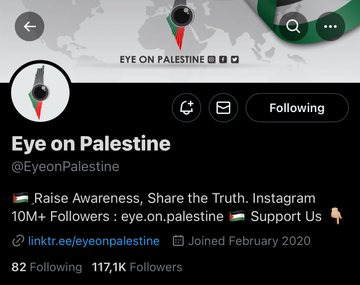

I urge everybody (art blogs, fandom blogs, etc) to put their interests on pause for the week and use that time to educate themselves on what's been going on for the last several years. This did not start in October. Keep speaking up and uplift Palestinian voices!
______________________________________________________________
Resources and other ways to help:
BOYCOTT STARBUCKS AND MCDONALDS (among other things)
Donate E-Sims to help journalists be in touch with the rest of the world
Stop supporting Zionist celebrities (ex: Noah Schnapp, Gal Gadot)
Uplift Palestinian journalists
Donate menstrual products to menstruating people in Gaza
Donations to UNRWA, Islamic Relief Canada, Arab (daily clicks and proceeds go to UNRWA)
If I missed anything, please feel free to message me or send me something in my inbox. Again, I urge everybody to pause their week to stand in solidarity with the Palestinian people and continue to uplift their voices. We are all stronger together.
#free palestine#palestine resources#tagging fandom-related things to increase exposure!!! please spread word!#I will refrain from posting DNP-related things for this week as well (with the occasional post to balance out for the algorithm so i don't-#get shadowbanned)#dan howell#phil lester#amazingphil#danisnotonfire#dan and phil#phandom#phan#dnp#dapgames#dan and phil games#dan and phil edit#fandom#meme#shitpost#from the river to the sea palestine will be free#ceasefire#free gaza#palestinian genocide#current events
292 notes
·
View notes
Text
Since the virtual reality service’s launch in 2021, the so-called “successor to the mobile internet” became the recipient of a kind of soaring hype few things are ever blessed with. According to Insider, McKinsey claimed that the Metaverse would bring businesses $5 trillion in value. Citi valued it at no less than $13 trillion.
There was only one problem: The whole thing was bullshit. Far from being worth trillions of dollars, the Metaverse turned out to be worth absolutely bupkus. It’s not even that the platform lagged behind expectations or was slow to become popular. There wasn’t anyone visiting the Metaverse at all.
The sheer scale of the hype inflation came to light in May. In the same article, Insider revealed that Decentraland, arguably the largest and most relevant Metaverse platform, had only 38 active daily users. The Guardian reported that one of the features designed to reward users in Meta’s flagship product Horizon Worlds produced no more than $470 in revenue globally. Thirty-eight active users. Four hundred and seventy dollars. You’re not reading those numbers wrong. To say that the Metaverse is dead is an understatement. It was never alive.
761 notes
·
View notes
Text
The United States is experiencing scorching new levels of heat fueled by climate change this summer, with dozens of people dying in the West, millions sweating under heat advisories and nearly three-quarters of Americans saying the government must prioritize global warming.
But as the Republican Party opens its national convention in Milwaukee with a prime-time focus on energy on Monday night, the party has no plan to address climate change.
While many Republicans no longer deny the overwhelming scientific consensus that the planet is warming, party leaders do not see it as a problem that needs to be addressed.
“I don’t know that there is a Republican approach to climate change as an organizing issue,” said Thomas J. Pyle, president of the American Energy Alliance, a conservative research group focused on energy. “I don’t think President Trump sees reducing greenhouse gases, using the government to do so, as an imperative.”
When former President Donald J. Trump mentions climate change at all, it is mockingly.
“Can you imagine, this guy says global warming is the greatest threat to our country?” Mr. Trump said, referring to President Biden as he addressed a rally in Chesapeake, Va., last month, the hottest June in recorded history across the globe. “Global warming is fine. In fact, I heard it was going to be very warm today. It’s fine.”
He went on to dismiss the scientific evidence that melting ice sheets in Antarctica and Greenland are causing seas to rise, threatening coastal communities around the world. He said it would result in “more waterfront property, if you’re lucky enough to own.” And he lapsed into familiar rants against windmills and electric vehicles.
At the televised debate with Mr. Biden in June, Mr. Trump was asked if he would take any action as president to slow the climate crisis. “I want absolutely immaculate clean water and I want absolutely clean air, and we had it,” Mr. Trump responded, without answering the question.
Mr. Trump’s spokeswoman, Karoline Leavitt, later declined to clarify the former president’s position or discuss any actions he would take regarding climate change, saying only that he wants “energy dominance.”
The United States last year pumped more crude oil than any country in history and is now the world’s biggest exporter of natural gas.
A clear majority of Americans, 65 percent, wants the country to focus on increasing solar, wind and other renewable energy and not fossil fuels, according to a May survey by the Pew Research Center. But just 38 percent of Republicans surveyed said renewable energy should be prioritized, while 61 percent said the country should focus on developing more oil, gas and coal.
“Their No. 1 agenda is to continue producing fossil fuels,” said Andrew Dessler, a professor of atmospheric sciences and the director of the Texas Center for Climate Studies at Texas A&M University. “Once you understand their main goal is to entrench fossil fuels regardless of anything else, everything makes sense.”
The party platform, issued last week, makes no mention of climate change. Instead, it encourages more production of oil, gas and coal, the burning of which is dangerously driving up global temperatures. “We will DRILL, BABY, DRILL,” it says, referring to oil as “liquid gold.”
By contrast, Mr. Biden has taken the most aggressive action of any president to cut emissions from coal, oil and gas and encourage a transition to wind, solar and other carbon-free energy. He has directed every federal agency from the Agriculture Department to the Pentagon to consider how climate change is affecting their core missions.
If Mr. Biden has taken an all-of-government approach to fighting climate change, Mr. Trump and his allies would adopt the opposite: scrubbing “climate” from all federal functions and promoting fossil fuels.
Mr. Trump and his allies want to end federal subsidies for electric vehicles, battery development and the wind and solar industries, preferring instead to open up the Alaskan wilderness to oil drilling, encourage more offshore drilling and expand gas export terminals.
Project 2025, a lengthy manual filled with specific proposals for a next Republican administration, calls for erasing any mention of climate change across the government. While Mr. Trump has recently sought to distance himself from Project 2025, he has praised its architects at the Heritage Foundation, a conservative research organization, and much of the plan was written by people who were top advisers during his first term and could serve in prominent roles if he wins in November.
When pressed to discuss climate change, some Republicans say the country should produce more natural gas and sell it to other countries as a cleaner replacement for coal.
While natural gas produces less carbon dioxide than coal when burned, it remains one of the sources of the greenhouse gases that are driving climate change. Scientists say that countries must stop burning coal, oil and gas to keep global warming to relatively safe levels. Last year, at the United Nations climate summit in Dubai, United Arab Emirates, the United States and nearly 200 countries agreed to transition away from fossil fuels.
But if elected, Mr. Trump has indicated he would pull back from the global fight against climate change, as he did when he announced in 2017 that the United States would be the first and only country to withdraw from the Paris Agreement to limit greenhouse gas emissions. (The United States subsequently rejoined under Mr. Biden.)
And it’s possible he would go even further. Mr. Trump’s former aides said that if he wins in November, he would remove the country altogether from the United Nations Framework Convention on Climate Change, the international body that works on climate policy and created the 2015 Paris deal.
When it comes to international relations, Project 2025 calls for an end to spending federal funds to help the world’s poorest countries transition to wind, solar and other renewable energy.
The blueprint also calls for erasing climate change as a national security concern, despite research showing rising sea levels, extreme weather and other consequences of global temperature rise are destabilizing areas of the world, affecting migration and threatening American military installations.
Federal research into climate change would slow or disappear under Project 2025, which recommends dismantling the National Oceanic and Atmospheric Administration, which conducts some of the world’s leading climate research and is also responsible for weather forecasting and tracking the path of hurricanes and other storms.
NOAA, according to the authors of Project 2025, is “one of the main drivers of the climate change alarm industry and, as such, is harmful to future U.S. prosperity.” At the agency’s research operation, which include a network of research laboratories, an undersea research center, and several joint research institutes with universities, “the preponderance of its climate-change research should be disbanded,” the blueprint said.
Project 2025 also calls for the president to issue an executive order to “reshape” the program that convenes 13 federal agencies every four years to produce the National Climate Assessment, the country’s most authoritative analysis of climate knowledge. The report is required by Congress and details the impacts and risks of climate change to a wide range of sectors, including agriculture, health care and transportation. It is used by the public, researchers and officials around the country to inform decisions about strategies and spending.
Project 2025 also calls for the elimination of offices at the Department of Energy dedicated to developing wind, solar and other renewable energy.
Waleed Abdalati, a former NASA chief scientist who is now at the University of Colorado Boulder, said downgrading climate science would be a disservice to the nation. “That’s a loss of four years in pursuit of creative solutions,” he said.
As president, Mr. Trump tried to replace top officials with political appointees who denied the existence of climate change and put pressure on federal scientists to water down their conclusions. Scientists refused to change their findings and attempts by the Trump administration to bury climate research were also not successful.
“Thank God they didn’t know how to run a government,” Thomas Armstrong, who led the National Climate Assessment program under the Obama administration, said at the end of Mr. Trump’s presidency, adding, “It could have been a lot worse.”
Next time, they would know how to run the government, Mr. Trump’s former officials said. “The difference between the last time and this time is, Donald Trump was president for four years,” Mr. Pyle said. “He will be more prepared.”
#climate change#climate action#global warming#Donald Trump#Trump#politics#us politics#american politics#election 2024#Republicans don't just not have a plan to fight climate change#they have a plan to make it much worse#the planet is on the line people
106 notes
·
View notes
Text
i’m disappointed to see that palestine isn’t currently trending on tumblr right now despite the global shut down today.
for one day, use your platform to share information — just one day.
show the world how angry we are; show the world how much we need a free palestine.
daily click: https://arab.org/click-to-help/palestine/
info on palestinian history: http://decolonizepalestine.com
care for gaza: https://twitter.com/careforgaza?s=21&t=PaZxE14niAllwspWdhiHjg
e-sims: https://gazaesims.com/esim-purchase-tutorial/
donating feminine products: http://piousprojects.org/campaign/2712
call for a ceasefire: http://ceasefiretoday.com
#free palestine#from the river to the sea palestine will be free#i’ll be updating with more links throughout the day
155 notes
·
View notes
Text
Couch surfer in his 30s. Oscar winner in his 40s. Why the whole world wants Taika
**Notes: This is very long post!**
Good Weekend
In his 30s, he was sleeping on couches. By his 40s, he’d directed a Kiwi classic, taken a Marvel movie to billion-dollar success, and won an Oscar. Meet Taika Waititi, king of the oddball – and one of New Zealand’s most original creative exports.
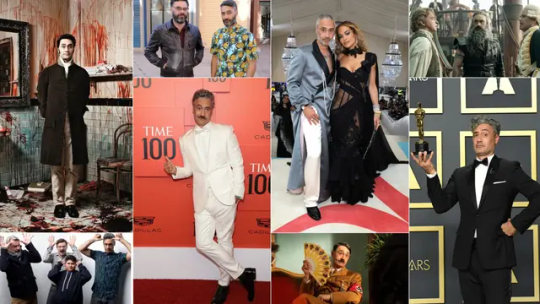
Taika Waititi: “Be a nice person and live a good life. And just don’t be an arsehole.”
The good news? Taika Waititi is still alive. I wasn’t sure. The screen we were speaking through jolted savagely a few minutes ago, with a cacophonous bang and a confused yelp, then radio silence. Now the Kiwi filmmaker is back, grinning like a loon: “I just broke the f---ing table, bro!”
Come again? “I just smashed this f---ing table and glass flew everywhere. It’s one of those old annoying colonial tables. It goes like this – see that?” Waititi says, holding up a folding furniture leg. “I hit the mechanism and it wasn’t locked. Anyway …”
I’m glad he’s fine. The stuff he’s been saying from his London hotel room could incur biblical wrath. We’re talking about his latest project, Next Goal Wins, a movie about the American Samoa soccer team’s quest to score a solitary goal, 10 years after suffering the worst loss in the game’s international history – a 31-0 ignominy to Australia – but our chat strays into spirituality, then faith, then religion.
“I don’t personally believe in a big guy sitting on a cloud judging everyone, but that’s just me,” Waititi says, deadpan. “Because I’m a grown-up.”
This is the way his interview answers often unfold. Waititi addresses your topic – dogma turns good people bad, he says, yet belief itself is worth lauding – but bookends every response with a conspiratorial nudge, wink, joke or poke. “Regardless of whether it’s some guy living on a cloud, or some other deity that you’ve made up – and they’re all made up – the message across the board is the same, and it’s important: Be a nice person, and live a good life. And just don’t be an arsehole!”
Not being an arsehole seems to have served Waititi, 48, well. Once a national treasure and indie darling (through the quirky tenderness of his breakout New Zealand films Boy in 2010 and Hunt for the Wilderpeople in 2016), Waititi then became a star of both the global box office (through his 2017 entry into the Marvel Universe, Thor: Ragnarok, which grossed more than $1.3 billion worldwide) and then the Academy Awards (winning the 2020 best adapted screenplay Oscar for his subversive Holocaust dramedy JoJo Rabbit, in which he played an imaginary Hitler).

Waititi playing Adolf Hitler in the 2019 movie JoJo Rabbit. (Alamy)
A handsome devil with undeniable roguish charm, Waititi also slid seamlessly into style-icon status (attending this year’s Met Gala shirtless, in a floor-length gunmetal-grey Atelier Prabal Gurung wrap coat, with pendulous pearl necklaces), as well as becoming his own brand (releasing an eponymous line of canned coffee drinks) and bona fide Hollywood A-lister (he was introduced to his second wife, British singer Rita Ora, by actor Robert Pattinson at a barbecue).
Putting that platform to use, Waititi is an Indigenous pioneer and mentor, too, co-creating the critically acclaimed TV series Reservation Dogs, while co-founding the Piki Films production company, committed to promoting the next generation of storytellers – a mission that might sound all weighty and worthy, yet Waititi’s new wave of First Nations work is never earnest,
always mixing hurt with heart and howling humour.
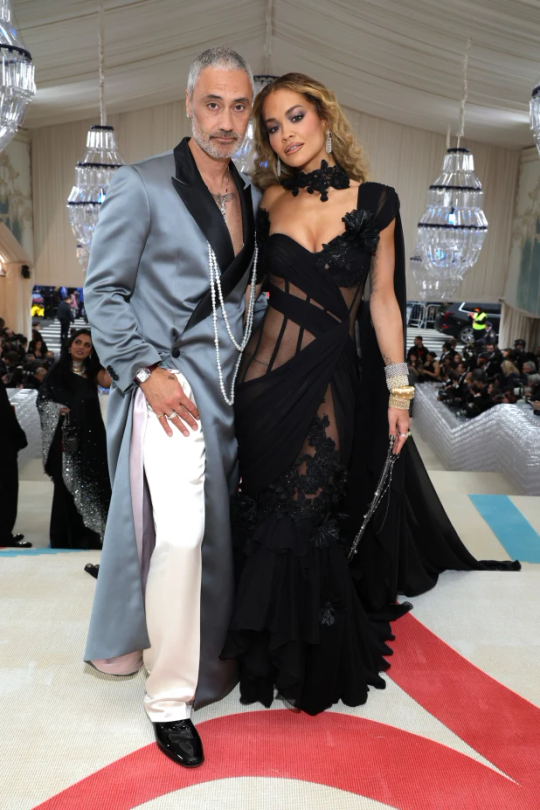
Waititi with wife Rita Ora at the 2023 Met Gala in May. (Getty Images)
Makes sense. Waititi is a byproduct of “the weirdest coupling ever” – his late Maori father from the Te Whanau-a-Apanui tribe was an artist, farmer and “Satan’s Slaves” bikie gang founder, while his Wellington schoolteacher mum descended from Russian Jews, although he’s not devout about her faith. (“No, I don’t practise,” he confirms. “I’m just good at everything, straight away.”)
He’s remained loyally tethered to his origin story, too – and to a cadre of creative Kiwi mates, including actors Jemaine Clement and Rhys Darby – never forgetting that not long before the actor/writer/producer/director was an industry maven, he was a penniless painter/photographer/ musician/comedian.
With no set title and no fixed address, he’s seemingly happy to be everything, everywhere (to everyone) all at once. “‘The universe’ is bandied around a lot these days, but I do believe in the kind of connective tissue of the universe, and the energy that – scientifically – we are made up of a bunch of atoms that are bouncing around off each other, and some of the atoms are just squished together a bit tighter than others,” he says, smiling. “We’re all made of the same stardust, and that’s pretty special.”
-----------------------------------------------
We’ve caught Waititi in a somewhat relaxed moment, right before the screen actors’ and media artists’ strike ends. He’s sensitive to the struggle but doesn’t deny enjoying the break. “I spent a lot of time thinking about writing, and not writing, and having a nice holiday,” he tells Good Weekend. “Honestly, it was a good chance just to recombobulate.”
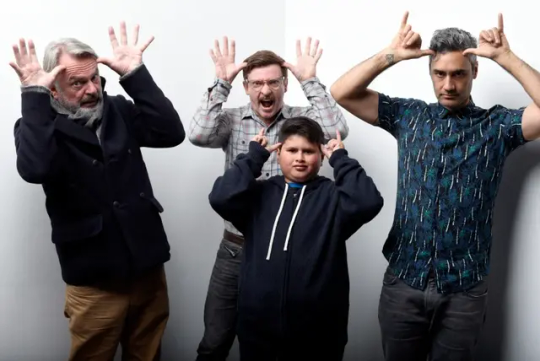
Waititi, at right, with Hunt for the Wilderpeople actors, from left, Sam Neill, Rhys Darby and Julian Dennison. (Getty Images)
It’s mid-October, and he’s just headed to Paris to watch his beloved All Blacks in the Rugby World Cup. He’s deeply obsessed with the game, and sport in general. “Humans spend all of our time knowing what’s going to happen with our day. There’s no surprises any more. We’ve become quite stagnant. And I think that’s why people love sport, because of the air of unpredictability,” he says. “It’s the last great arena entertainment.”
The main filmic touchstone for Next Goal Wins (which premieres in Australian cinemas on New Year’s Day) would be Cool Runnings (1993), the unlikely true story of a Jamaican bobsled team, but Waititi also draws from genre classics such as Any Given Sunday and Rocky, sampling trusted tropes like the musical training montage. (His best one is set to Everybody Wants to Rule the World by Tears for Fears.)
Filming in Hawaii was an uplifting experience for the self-described Polynesian Jew. “It wasn’t about death, or people being cruel to each other. Thematically, it was this simple idea, of getting a small win, and winning the game wasn’t even their goal – their goal was to get a goal,” he says. “It was a really sweet backbone.”
Waititi understands this because, growing up, he was as much an athlete as a nerd, fooling around with softball and soccer before discovering rugby league, then union. “There’s something about doing exercise when you don’t know you’re doing exercise,” he enthuses. “It’s all about the fun of throwing a ball around and trying to achieve something together.” (Whenever Waititi is in Auckland he joins his mates in a long-running weekend game of touch rugby. “And then throughout the week I work out every day. Obviously. I mean, look at me.”)
Auckland is where his kids live, too, so he spends as much time there as possible. Waititi met his first wife, producer Chelsea Winstanley, on the set of Boy in 2010, and they had two daughters, Matewa Kiritapu, 8, and his firstborn, Te Kainga O’Te Hinekahu, 11. (The latter is a derivative of his grandmother’s name, but he jokes with American friends that it means “Resurrection of Tupac” or “Mazda RX7″) Waititi and Winstanley split in about 2018, and he married the pop star Ora in 2022.
He offers a novel method for balancing work with parenthood … “Look, you just abandon them, and know that the experience will make them harder individuals later on in life. And it’s their problem,” he says. “I’m going to give them all of the things that they need, and I’m going to leave behind a decent bank account for their therapy, and they will be just like me, and the cycle will continue.”
Jokes aside – I think he’s joking – school holidays are always his, and he brings the girls onto the set of every movie he makes. “They know enough not to get in the way or touch anything that looks like it could kill you, and they know to be respectful and quiet when they need to. But they’re just very comfortable around filmmakers, which I’m really happy about, because eventually I hope they will get into the industry. One more year,” he laughs, “then they can leave school and come work for Dad.”
Theirs is certainly a different childhood than his. Growing up, he was a product of two worlds. His given names, for instance, were based on his appearance at birth: “Taika David” if he looked Maori (after his Maori grandfather) and “David Taika” if he looked Pakeha (after his white grandfather). His parents split when he was five, so he bounced between his dad’s place in Waihau Bay, where he went by the surname Waititi, and his mum, eight hours drive away in Wellington, where he went by Cohen (the last name on his birth certificate and passport).
Waititi was precocious, even charismatic. His mother Robin once told Radio New Zealand that people always wanted to know him, even as an infant: “I’d be on a bus with him, and he was that kind of baby who smiled at people, and next thing you know they’re saying, ‘Can I hold your baby?’ He’s always been a charmer to the public eye.”
He describes himself as a cool, sporty, good-looking nerd, raised on whatever pop culture screened on the two TV channels New Zealand offered in the early 1980s, from M*A*S*H and Taxi to Eddie Murphy and Michael Jackson. He was well-read, too. When punished by his mum, he would likely be forced to analyse a set of William Blake poems.
He puts on a whimpering voice to describe their finances – “We didn’t have much monneeey” – explaining how his mum spent her days in the classroom but also worked in pubs, where he would sit sipping a raspberry lemonade, doodling drawings and writing stories. She took in ironing and cleaned houses; he would help out, learning valuable lessons he imparts to his kids. “And to random people who come to my house,” he says. “I’ll say, ‘Here’s a novel idea, wash this dish,’ but people don’t know how to do anything these days.”
“Every single character I’ve ever written has been based on someone I’ve known or met or a story I’ve stolen from someone.” - Taika Waititi
He loved entertaining others, clearly, but also himself, recording little improvised radio plays on a tape deck – his own offbeat versions of ET and Indiana Jones and Star Wars. “Great free stuff where you don’t have any idea what the story is as you’re doing it,” he says. “You’re just sort of making it up and enjoying the freedom of playing god in this world where you can make people and characters do whatever you want.”
His other sphere of influence lay in Raukokore, the tiny town where his father lived. Although Boy is not autobiographical, it’s deeply personal insofar as it’s filmed in the house where he grew up, and where he lived a life similar to that portrayed in the story, surrounded by his recurring archetypes: warm grandmothers and worldly kids; staunch, stoic mums; and silly, stunted men. “Every single character I’ve ever written has been based on someone I’ve known or met,” he says, “or a story I’ve stolen from someone.”
He grew to love drawing and painting, obsessed early on with reproducing the Sistine Chapel. During a 2011 TED Talk on creativity, Waititi describes his odd subject matter, from swastikas and fawns to a picture of an old lady going for a walk … upon a sword … with Robocop. “My father was an outsider artist, even though he wouldn’t know what that meant,” Waititi told the audience in Doha. “I love the naive. I love people who can see things through an innocent viewpoint. It’s inspiring.”
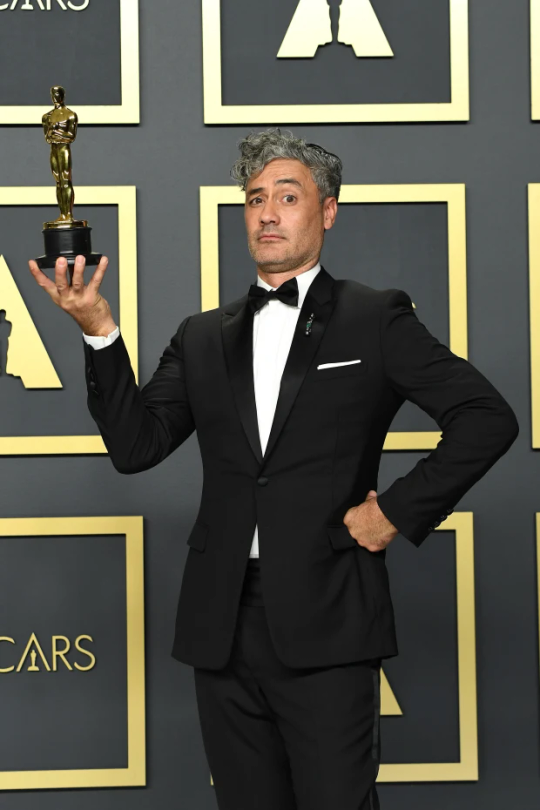
After winning Best Adapted Screenplay Academy Award for JoJo Rabbit in 2020. (Getty Images)
It was an interesting time in New Zealand, too – a coming-of-age decade in which the Maori were rediscovering their culture. His area was poor, “but only financially,” he says. “It’s very rich in terms of the people and the culture.” He learned kapa haka – the songs, dances and chants performed by competing tribes at cultural events, or to honour people at funerals and graduations – weddings, parties, anything. “Man, any excuse,” he explains. “A big part of doing them is to uplift your spirits.”
Photography was a passion, so I ask what he shot. “Just my penis. I sent them to people, but we didn’t have phones, so I would print them out, post them. One of the first dick pics,” he says. Actually, his lens was trained on regular people. He watches us still – in airports, restaurants. “Other times late at night, from a tree. Whatever it takes to get the story. You know that.”
He went to the Wellington state school Onslow College and did plays like Androcles and the Lion, A Midsummer Night’s Dream and The Crucible. His crew of arty students eventually ended up on stage at Bats Theatre in the city, where they would perform haphazard comedy shows for years.
“Taika was always rebellious and wild in his comedy, which I loved,” says his high school mate Jackie van Beek, who became a longtime collaborator, including working with Waititi on a Tourism New Zealand campaign this year. “I remember he went through a phase of turning up in bars around town wearing wigs, and you’d try and sit down and have a drink with him but he’d be doing some weird character that would invariably turn up in some show down the track.”
He met more like-minded peers at Victoria University, including Jemaine Clement (who’d later become co-creator of Flight of the Conchords). During a 2019 chat with actor Elijah Wood, Waititi describes he and Clement clocking one another from opposite sides of the library one day: a pair of Maoris experiencing hate at first sight, based on a mutual suspicion of cultural appropriation. (Clement was wearing a traditional tapa cloth Samoan shirt, and Waititi was like: “This motherf---er’s not Samoan.” Meanwhile, Waititi was wearing a Rastafarian beanie, and Clement was like, “This motherf---er’s not Jamaican.”)
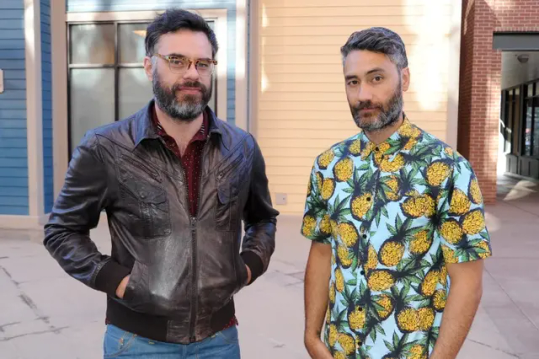
With Jemaine Clement in 2014. (Getty Images)
But they eventually bonded over Blackadder and Fawlty Towers, and especially Kenny Everett, and did comedy shows together everywhere from Edinburgh to Melbourne. Waititi was almost itinerant, spending months at a time busking, or living in a commune in Berlin. He acted in a few small films, and then – while playing a stripper on a bad TV show – realised he wanted to try life behind the camera. “I became tired of being told what to do and ordered around,” he told Wellington’s Dominion Post in 2004. “I remember sitting around in the green room in my G-string thinking, ‘Why am I doing this? Just helping someone else to realise their dream.’ ”
He did two strong short films, then directed his first feature – Eagle vs Shark (2007) – when he was 32. He brought his mates along (Clement, starring with Waititi’s then-girlfriend Loren Horsley), setting something of a pattern in his career: hiring friends instead of constantly navigating new working relationships. “If you look at things I’m doing,” he tells me, “there’s always a few common denominators.”
Sam Neill says Waititi is the exemplar of a new New Zealand humour. “The basis of it is this: we’re just a little bit crap at things.”
This gang of collaborators shares a common Kiwi vibe, too, which his longtime friend, actor Rhys Darby, once coined “the comedy of the mundane”. Their new TV show, Our Flag Means Death, for example, leans heavily into the mundanity of pirate life – what happens on those long days at sea when the crew aren’t unsheathing swords from scabbards or burying treasure.

Waititi plays pirate captain Blackbeard, centre, in Our Flag Means Death, with Rhys Darby, left, and Rory Kinnear. (Google Images)
Sam Neill, who first met Waititi when starring in Hunt for the Wilderpeople, says Waititi is the exemplar of a new New Zealand humour. “And I think the basis of it is this,” says Neill. “We’re just a little bit crap at things, and that in itself is funny.” After all, Neill asks, what is What We Do in The Shadows (2014) if not a film (then later a TV show) about a bunch of vampires who are pretty crap at being vampires, living in a pretty crappy house, not quite getting busted by crappy local cops? “New Zealand often gets named as the least corrupt country in the world, and I think it’s just that we would be pretty crap at being corrupt,” Neill says. “We don’t have the capacity for it.”
Waititi’s whimsy also spurns the dominant on-screen oeuvre of his homeland – the so-called “cinema of unease” exemplified by the brutality of Once Were Warriors (1994) and the emotional peril of The Piano (1993). Waititi still explores pathos and pain, but through laughter and weirdness. “Taika feels to me like an antidote to that dark aspect, and a gift somehow,” Neill says. “And I’m grateful for that.”
-----------------------------------------------
Something happened to Taika Waititi when he was about 11 – something he doesn’t go into with Good Weekend, but which he considered a betrayal by the adults in his life. He mentioned it only recently – not the moment itself, but the lesson he learnt: “That you cannot and must not rely on grown-ups to help you – you’re basically in the world alone, and you’re gonna die alone, and you’ve just gotta make it all for yourself,” he told Irish podcast host James Brown. “I basically never forgave people in positions of responsibility.”
What does that mean in his work? First, his finest films tend to reflect the clarity of mind possessed by children, and the unseen worlds they create – fantasies conjured up as a way to understand or overcome. (His mum once summed up the main message of Boy: “The unconditional love you get from your children, and how many of us waste that, and don’t know what we’ve got.”)
Second, he’s suited to movie-making – “Russian roulette with art” – because he’s drawn to disruptive force and chaos. And that in turn produces creative defiance: allowing him to reinvigorate the Marvel Universe by making superheroes fallible, or tell a Holocaust story by making fun of Hitler. “Whenever I have to deal with someone who’s a boss, or in charge, I challenge them,” he told Brown, “and I really do take whatever they say with a pinch of salt.”
It’s no surprise then that Waititi was comfortable leaping from independent films to the vast complexity of Hollywood blockbusters. He loves the challenge of coordinating a thousand interlocking parts, requiring an army of experts in vocations as diverse as construction, sound, art, performance and logistics. “I delegate a lot,” he says, “and share the load with a lot of people.”
“This is a cool concept, being able to afford whatever I want, as opposed to sleeping on couches until I was 35.” - Taika Waititi
But the buck stops with him. Time magazine named Waititi one of its Most Influential 100 People of 2022. “You can tell that a film was made by Taika Waititi the same way you can tell a piece was painted by Picasso,” wrote Sacha Baron Cohen. Compassionate but comic. Satirical but watchable. Rockstar but auteur. “Actually, sorry, but this guy’s really starting to piss me off,” Cohen concluded. “Can someone else write this piece?”

Directing Chris Hemsworth in 2017 in Thor: Ragnarok, which grossed more than $1.3 billion at the box office. (Alamy)
I’m curious to know how he stays grounded amid such adulation. Coming into the game late, he says, helped immensely. After all, Waititi was 40 by the time he left New Zealand to do Thor: Ragnarok. “If you let things go to your head, then it means you’ve struggled to find out who you are,” he says. “But I’ve always felt very comfortable with who I am.” Hollywood access and acclaim – and the pay cheques – don’t erase memories of poverty, either. “It’s more like, ‘Oh, this is a cool concept, being able to afford whatever I want, as opposed to sleeping on couches until I was 35.’ ” Small towns and strong tribes keep him in check, too. “You know you can’t piss around and be a fool, because you’re going to embarrass your family,” he says. “Hasn’t stopped me, though.”
Sam Neill says there was never any doubt Waititi would be able to steer a major movie with energy and imagination. “It’s no accident that the whole world wants Taika,” he says. “But his seductiveness comes with its own dangers. You can spread yourself a bit thin. The temptation will be to do more, more, more. That’ll be interesting to watch.”
Indeed, I find myself vicariously stressed out over the list of potential projects in Waititi’s future. A Roald Dahl animated series for Netflix. An Apple TV show based on the 1981 film Time Bandits. A sequel to What We Do In The Shadows. A reboot of Flash Gordon. A gonzo horror comedy, The Auteur, starring Jude Law. Adapting a cult graphic novel, The Incal, as a feature. A streaming series based on the novel Interior Chinatown. A film based on a Kazuo Ishiguro bestseller. Plus bringing to life the wildly popular Akira comic books. Oh, and for good measure, a new instalment of Star Wars, which he’s already warned the world will be … different.
“It’s going to change things,” he told Good Morning America. “It’s going to change what you guys know and expect.”
Did I say I was stressed for Waititi? I meant physically sick.
“Well…” he qualifies, “some of those things I’m just producing, so I come up with an idea or someone comes to me with an idea, and I shape how ‘it’s this kind of show’ and ‘here’s how we can get it made.’ It’s easier for me to have a part in those things and feel like I’ve had a meaningful role in the creative process, but also not having to do what I’ve always done, which is trying to control everything.”

In the 2014 mockumentary horror film What We Do in the Shadows, which he co-directed with Jemaine Clement. (Alamy)
What about moving away from the niche New Zealand settings he represented so well in his early work? How does he stay connected to his roots? “I think you just need to know where you’re from,” he says, “and just don’t forget that.”
They certainly haven’t forgotten him.
Jasmin McSweeney sits in her office at the New Zealand Film Commission in Wellington, surrounded by promotional posters Waititi signed for her two decades ago, when she was tasked with promoting his nascent talent. Now the organisation’s marketing chief, she talks to me after visiting the heart of thriving “Wellywood”, overseeing the traditional karakia prayer on the set of a new movie starring Geoffrey Rush.
Waititi isn’t the first great Kiwi filmmaker – dual Oscar-winner Jane Campion and blockbuster king Peter Jackson come to mind – yet his particular ascendance, she says, has spurred unparalleled enthusiasm. “Taika gave everyone here confidence. He always says, ‘Don’t sit around waiting for people to say, you can do this.’ Just do it, because he just did it. That’s the Taika effect.”
-----------------------------------------------
Taika David Waititi is known for wearing everything from technicolour dreamcoats to pineapple print rompers, and today he’s wearing a roomy teal and white Isabel Marant jumper. The mohair garment has the same wispy frizz as his hair, which curls like a wave of grey steel wool, and connects with a shorn salty beard.
A stylish silver fox, it wouldn’t surprise anyone if he suddenly announced he was launching a fashion label. He’s definitely a commercial animal, to the point of directing television commercials for Coke and Amazon, along with a fabulous 2023 spot for Belvedere vodka starring Daniel Craig. He also joined forces with a beverage company in Finland (where “taika” means “magic”) to release his coffee drinks. Announcing the partnership on social media, he flagged that he would be doing more of this kind of stuff, too (“Soz not soz”).
Waititi has long been sick of reverent portrayals of Indigenous people talking to spirits.
There’s substance behind the swank. Fashion is a creative outlet but he’s also bought sewing machines in the past with the intention of designing and making clothes, and comes from a family of tailors. “I learnt how to sew a button on when I was very young,” he says. “I learnt how to fix holes or patches in your clothes, and darn things.”
And while he gallivants around the globe watching Wimbledon or modelling for Hermès at New York Fashion Week, all that glamour belies a depth of purpose, particularly when it comes to Indigenous representation.
There’s a moment in his new movie where a Samoan player realises that their Dutch coach, played by Michael Fassbender, is emotionally struggling, and he offers a lament for white people: “They need us.” I can’t help but think Waititi meant something more by that line – maybe that First Nations people have wisdom to offer if others will just listen?
“Weeelllll, a little bit …” he says – but from his intonation, and what he says next, I’m dead wrong. Waititi has long been sick of reverent portrayals of Indigenous people talking to kehua (spirits), or riding a ghost waka (phantom canoe), or playing a flute on a mountain. “Always the boring characters,” he says. “They’ve got no real contemporary relationship with the world, because they’re always living in the past in their spiritual ways.”

A scene from Next Goal Wins, filmed earlier this year. (Alamy)
He’s part of a vanguard consciously poking fun at those stereotypes. Another is the Navajo writer and director Billy Luther, who met Waititi at Sundance Film Festival back in 2003, along with Reservation Dogs co-creator Sterlin Harjo. “We were this group of outsiders trying to make films, when nobody was really biting,” says Luther. “It was a different time. The really cool thing about it now is we’re all working. We persevered. We didn’t give up. We slept on each other’s couches and hung out. It’s like family.”
Waititi has power now, and is known for using Indigenous interns wherever possible (“because there weren’t those opportunities when I was growing up”), making important introductions, offering feedback on scripts, and lending his name to projects through executive producer credits, too, which he did for Luther’s new feature film, Frybread Face and Me (2023).
He called Luther back from the set of Thor: Love and Thunder (2022) to offer advice on working with child actors – “Don’t box them into the characters you’ve created,” he said, “let them naturally figure it out on their own” – but it’s definitely harder to get Waititi on the phone these days. “He’s a little bitch,” Luther says, laughing. “Nah, there’s nothing like him. He’s a genius. You just knew he was going to be something. I just knew it. He’s my brother.“
I’ve been asked to explicitly avoid political questions in this interview, probably because Waititi tends to back so many causes, from child poverty and teenage suicide to a campaign protesting offshore gas and oil exploration near his tribal lands. But it’s hard to ignore his recent Instagram post, sharing a viral video about the Voice to Parliament referendum starring Indigenous Aussie rapper Adam Briggs. After all, we speak only two days after the proposal is defeated. “Yeah, sad to say but, Australia, you really shat the bed on that one,” Waititi says, pausing. “But go see my movie!”
About that movie – the early reviews aren’t great. IndieWire called it a misfire, too wrapped in its quirks to develop its arcs, with Waititi’s directorial voice drowning out his characters, while The Guardian called it “a shoddily made and strikingly unfunny attempt to tell an interesting story in an uninteresting way”. I want to know how he moves past that kind of criticism. “For a start, I never read reviews,” he says, concerned only with the opinion of people who paid for admission, never professional appraisals. “It’s not important to me. I know I’m good at what I do.”
Criticism that Indigenous concepts weren’t sufficiently explained in Next Goal Wins gets his back up a little, though. The film’s protagonist, Jaiyah Saelua, the first transgender football player in a FIFA World Cup qualifying match, is fa’afafine – an American Samoan identifier for someone with fluid genders – but there wasn’t much exposition of this concept in the film. “That’s not my job,” Waititi says. “It’s not a movie where I have to explain every facet of Samoan culture to an audience. Our job is to retain our culture, and present a story that’s inherently Polynesian, and if you don’t like it, you can go and watch any number of those other movies out there, 99 per cent of which are terrible.”
*notes: (there is video clip in the article)
Waititi sounds momentarily cranky, but he’s mostly unflappable and hilarious. He’s the kind of guy who prefers “Correctumundo bro!” to “Yes”. When our video connection is too laggy, he plays up to it by periodically pretending to be frozen, sitting perfectly still, mouth open, his big shifting eyeballs the only giveaway.
He’s at his best on set. Saelua sat next to him in Honolulu while filming the joyous soccer sequences. “He’s so chill. He just let the actors do their thing, giving them creative freedom, barely interjecting unless it was something important. His style matches the vibe of the Pacific people. We’re a very funny people. We like to laugh. He just fit perfectly.”
People do seem to love working alongside him, citing his ability to make productions fresh and unpredictable and funny. Chris Hemsworth once said that Waititi’s favourite gag is to “forget” that his microphone is switched on, so he can go on a pantomime rant for all to hear – usually about his disastrous Australian lead actor – only to “remember” that he’s wired and the whole crew is listening.
“I wouldn’t know about that, because I don’t listen to what other people say about anything – I’ve told you this,” Waititi says. “I just try to have fun when there’s time to have fun. And when you do that, and you bring people together, they’re more willing to go the extra mile for you, and they’re more willing to believe in the thing that you’re trying to do.”
Yes, he plays music between takes, and dances out of his director’s chair, but it’s really all about relaxing amid the immense pressure and intense privilege of making movies. “Do you know how hard it is just to get anything financed or green-lit, then getting a crew, getting producers to put all the pieces together, and then making it to set?” Waititi asks. “It’s a real gift, even to be working, and I feel like I have to remind people of that: enjoy this moment.”
Source: The Age
By: Konrad Marshall (December 1, 2023)
197 notes
·
View notes
Text
Producer 'Yuan' Wan Thabkrajang, CEO of YYDS Entertainment - iQIYI Exclusive Interview Transcript

[Why did you choose this novel to make into a TV series adaptation?]
First of all, I think it's the hardship presented in 2023, which is most Thai Y (BL) novels have already been chosen/bought by other production companies in Thailand. Moreover, after reviewing numerous novels from various publishers, none seemed intriguing or had a genre that was refreshing enough for me to buy the adaptation rights to make a series. So, I looked to neighboring countries like Japan, South Korea, or China. They've been rather successful with their Y/BL novels so there might have been some interesting plots. Additionally, China is a country with a flourishing novel industry and a platform, with many famous novels that have millions of readers. And "My Stand-In" is among one of the famous BL novels so I decided to adapt it into a series.
[How do you feel about this being the "first Chinese danmei novel" to be adapted into a Thai TV series?]
This marks the first time a Chinese danmei novel has been adapted into a Thai TV series. Besides, after selecting the project, there were extensive discussions with the director and scriptwriters on how to localize it effectively so that the audience can immerse themselves in the narrative. Because the original work is Chinese, the storytelling or even the storylines are all very based on Chinese culture. The key point of what we needed to do is to make Thai viewers immerse in the series, but still keep the intriguing and intense plots of the novel. This is the hardest thing. But after starting the execution, I felt like the story lines and plots of original Chinese novel can be kept in full, but we needed to choose which plot points to be the main storyline. And because there's only 12 episodes, we'd have to decide which plotlines we are going to cut/shortened. That was one of the things we have to do as well.
[What are the challenges of this series?]
The challenge is the original work, because the original novel has a lot of reader fans and has billions of views. The challenge is to make the book fans satisfied with the adapted plot while making it into a Thai version. At the same time, we needed to figure out how to make the TV series popular in Thailand. Because even though the original novel has a lot of views in China, it's still a relatively new work in Thailand. So we thought about how can we make this Thai drama popular around the globe?
[Why did you decide to work with Director Pepzi?]
It's rather a miracle, because like I had to do research first to see in the past year... So this project started around January 2023, first we started exploring over the last two years to see which BL series was kinda explosive on the market, like able to reach worldwide or international popularity. Because we aimed to create a Thai series with global appeal. And so Director Pepzi is one of the directors, who I felt, has an extensive portfolio of works, both domestically and internationally, so I tried calling P'Pepzi. And that day, that evening, we only discussed for one evening and in the morning the day after, P'Pep texted back 'Yeah Yuan, I'll take this drama" and it's decided right then.
[What are the difficulties in adapting this novel into a TV series?]
It was challenging, especially in discussions with Director Pepzi like "How do you feel about this?... how do you want this to be? like on how to portray certain scenes and characters. Or considering Joe's profession as a stuntman, which means that action scenes are a must. Because in the novel, the action scenes would be in the style of classic Chinese ancient times. However, replicating them in a Thai context proved difficult if we tried to doing them exactly like in the novel. We had to find a balance that resonated with Thai audiences while retaining the novel's essence, this is one of the hardest things. The producers also think, in this year, if we do it the ordinary or typical way, not up to certain standards or not having any challenges, then the series wouldn't meet the selection criteria of viewers. Because these days, viewers tend to select and has a demand for higher-quality content. So we collaborated with the production team to outline the requirements on how we can turn this series into a masterpiece in the industry.
I also disccused with P'Khom about the action scenes or about set designs, things like that. We also had our colleagues from the design department create new sets, for example like Joe's room, that room is originally a warehouse in which we constructed a brand new set (t/n: basically Yuan is trying to say that the design team built Joe's house from scratch because the originally the location is just an empty warehouse). I also felt that the producers were betting big on action scenes. Even though the proportion of action scenes didn't exceed 30%, they were all meticulously designed to look outstanding. This was to evoke excitement and showcase the excellent capabilities of Thailand's production team.
[Interesting facts about 'Up-Poom' and their characters 'Ming-Joe']
Regarding the casting process, it took us 8 to 9 months to finalize the entire cast. And Up-Poom is a pairing where I felt like they had very matching chemistry. Especially when they were paired up during auditions, they even switched roles, with Up playing both Joe and Ming and Poom playing both Ming and Joe. We tried switching the roles to test the chemistry between them. And we found that they were very natural and compatible together, making them suitable for the main roles. Hence, we decided we decided to cast Up and Poom.
As for Ming and Joe, you'll know after reading the novel. Ming is the most detestable character and so Up portrayed him excellently, making everyone itch with hatred during filming. We couldn't understand why Ming acted that way, feeling sorry for Poom's character, Joe, for being mistreated and have to endure to this extent. However, behind the scenes, Up and Poom were quite mischievous, often playing pranks on each other, which made us not feel as sorry for them. Nevertheless, both of them portrayed their roles excellently.
[Recommend 'My Stand-In' to everyone]
Everyone, please pay attention to Stand-in. This TV series has a fascinating plot with elements of drama, romance, and action. It's also the first Thai original series on iQIYI. Please follow it on iQIYI.
#my stand in the series#my stand in#yyds entertainment#yuan wan thabkrajang#i tried cleaning up yuan's iqiyi interview as well since it wasn't too long#love that her mission is to make higher quality content#you can also see that the series lean much into appealing to novel fans while aiming to strike a balance for general bl audience#i WANNA SEE a serious audition clip of up playing joe and poom playing ming#YYDS GIVE IT TO US
71 notes
·
View notes